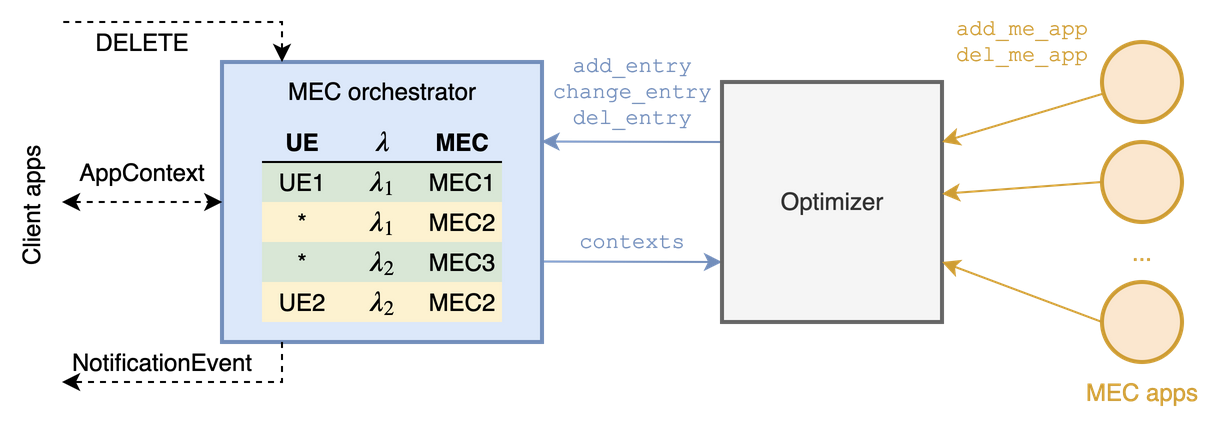Published in IEEE Communications Magazine, BibTeX here.
GitHub repository: Serverless on Edge
Authors: C. Cicconetti, M. Conti, A. Passarella, and D. Sabella
Topics
Challenges
How to optimize run-time execution of stateless tasks executed on ETSI MEC hosts upon changing conditions?
Key contributions
The target system is illustrated in the following picture.

MEC hosts are deployed by the Mobile Network Operator (MNO) close to the Base Stations to enable low-latency / high-bandwidth applications. The MEC hosts rely on a virtualized computation and communication infrastructure, which is controlled by the Virtualized Infrastructure Manager, hosted in the MNO’s core network. The MEC hosts run MEC applications that are deployed and managed by the MEC Orchestrator (MEO), whereas the MEC Platform Manager (MEPM) is in charge of managing MEC services that may be offered by the MNO to the MEC applications for (e.g.) user localization or bandwidth reservation.
In the paper we focus on MEC applications only (not on MEC services), in particular we address serverless platforms, i.e., solutions that allow clients to invoke functions/triggers in a stateless manner. Examples of open source serverless platforms are OpenWhisk and Knative; most cloud operators also offer custom serverless solutions, e.g., AWS Lambda.
According to the ETSI MEC architecture, the applications on the
user terminal interact with the ETSI MEC system via the Mx2 REST
interface, which allows to discover the available MEC applications
and to create application contexts for the offloading of (usually
computationally-intensive) tasks from the mobile device to the MEC
hosts. The ETSI MEC does not specify how to bind every user/application
to a given MEC host, which is left unspecified to foster competition
among vendors.
With traditional (i.e., stateful) applications, there is a 1:1 mapping between the client application (running in the user terminal) and the MEC application counterpart (running in one of the MEC hosts). A MEC application does not exist before the client application requested it, and it can be torn down as soon as it is not needed anymore.
On the other hand, with serverless the relation is N:M since:
-
a given client application may require the invocations of a sequence of functions;
-
the same instance of an executor in a MEC host may serve different client applications at the same time.
Also, life cycle management becomes more blurred: a given executor may exist even though no client application has requested it so far, or is currently invoking its actions, just in case some clients in the future will request the execution of that lambda function.
This creates a heavier than usual burden on the MEC orchestrator, which we propose to reduce by means of a split design illustrated below.

-
the MEC orchestrator takes fast decisions based on a table that maps the user terminal and requested lambda function identifiers to a MEC host: when a client requests a new context to be created for the subsequent execution of lambda functions, the orchestrator has to simply perform a look-up in that table;
-
the table is updated periodically by an external component, called Optimizer in the figure, which is notified about the number of contexts currently active and whenever a new MEC (serveless) application is created or torn down in a MEC host; the last step can be done with ETSI MEC on the
Mp1REST interface (not implemented in our prototype).
In our prototype available here we have defined gRPC interfaces for the Optimizer, with the methods illustrated in the diagram above.
In our study we then explore three possibilities:
-
Baseline solution: when the Optimizer updates the table, the changes only affect contexts that will be created in the future. Thus, the current mapping between client applications and MEC hosts could be sub-optimal because it is not immediately reflected on the system.
-
Notification solution: as the table changes, all the currently active contexts affected by the change are notified through a
POSTcommand issued by the MEC orchestrator towards the clients, at an URL that has been specified upon context creation. Note this solution allows the optimal mapping to be enforced immediately, but only in the assumption that the client applications run an HTTP server to receive notifications, which is possible but not mandatory in ETSI MEC. -
Distributed dispatching: we implement a distribution solution where the incoming lambda invocation requests are always directed to a given MEC applications, which however acts as a broker towards the (multiple) serverless platforms runnin as MEC applications too. For this we could implement the solutions that we have studied here or here.
Validation
We have carried out preliminary validation through emulation using our framework described here.
Main findings:
-
With fast changing conditions, due to either mobility of traffic distribution, the notification solution and distributed dispatching described above provide client applications with more consistent performance, in terms of the response time of lamdba function invocations.
-
This comes at a cost in terms of client application complexity (for the notification solution, which requires an HTTP server to receive
POSTcommands) or network traffic (for the distributed dispatching).
Future work
- Integration of our open source prototype with OpenNESS or the ETSI MEC emulation platform